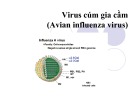
Bài giảng Influenza viruses
-
Đại cương: + Là bệnh truyền nhiễm cấp tính do virus Influenza gây ra, rất hay lây + Dễ gây dịch lớn + LS: Nhức đầu, đau mình, sốt, ho, kiệt sức + Gần đây dịch cúm gia cầm A (H5N1) xuất hiện ở nhiều nơi làm cả thế giới lo lắng tìm biện pháp đối phó
 48p
48p  womanhood911_09
womanhood911_09
 10-11-2009
10-11-2009
 667
667
 346
346
 Download
Download
-
Bài giảng Influenza viruses do ThS. Dương Hồng Phúc biên soạn sau đây sẽ giới thiệu tới các bạn những kiến thức đại cương về Influenza viruses; cấu trúc của Influenza viruses; danh pháp; kháng nguyên - kháng thể của Influenza viruses; miễn dịch học, tính chất của Influenza viruses; bệnh học của Influenza viruses;... Với các bạn chuyên ngành Y học thì đây là tài liệu hữu ích.
 41p
41p  thuytrang_6
thuytrang_6
 13-08-2015
13-08-2015
 113
113
 14
14
 Download
Download
-
Virus cúm gia cầm là một virus gây bệnh dịch rất lớn, có tính chất khốc liệt trên gia cầm nói chung, trong đó gà là mẫn cảm nhất. Trong bài giảng này sẽ cung cấp cho người học một số kiến thức cơ bản về loại virus này như: Tình hình chung về bệnh cúm, đặc tính sinh học của virus cúm gia cầm, chẩn đoán virus học,... Mời các bạn cùng tham khảo.
 79p
79p  tangtuy12
tangtuy12
 02-06-2016
02-06-2016
 236
236
 40
40
 Download
Download
-
Đại cương: Sởi là bệnh được mô tả lần đầu tiên vào thế kỷ thứ X do y sĩ Persan Rhazes. Mãi đến thế kỷ thứ XVIII, Home mới có những công trình thực nghiệm về sự truyền bệnh. Virus sởi thuộc họ Paramyxovirus influenzae. Virus thuộc nhóm này giống nhau về tính kháng nguyên, nhưng virus sởi không có men neuraminidase, vì vậy nó không được hấp thu bởi những receptor của tế bào có chứa acid neuraminidic. Virus sởi có chứa ngưng kết tố hồng cầu, trong khi đó virus thuộc nhóm Paramyxovirus như Rinderpest và...
 5p
5p  bacsinhanhau
bacsinhanhau
 12-10-2010
12-10-2010
 109
109
 16
16
 Download
Download
CHỦ ĐỀ BẠN MUỐN TÌM
















